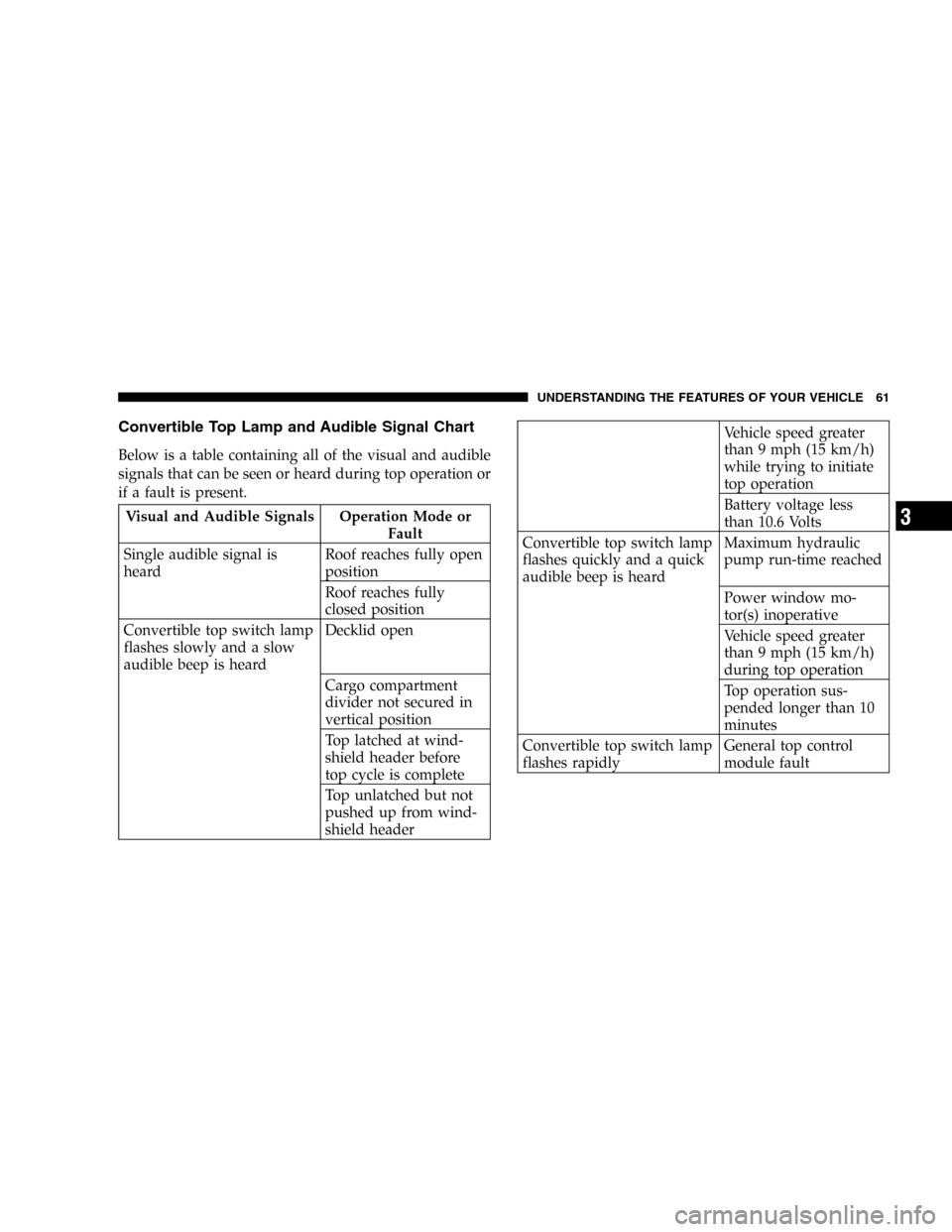2005 CHRYSLER CROSSFIRE SRT ECU
[x] Cancel search: ECUPage 59 of 280

7. When the top engages to the header, turn the latch
handle counterclockwise just over one quarter turn to the
lock position and push the latch handle up to the stored
position. The top is now secured in the closed position.
NOTE:The convertible top switch indicator will light
up and an audible warning will be heard if you start
driving the vehicle without the top fully locked in the
closed position.8. Once the top has been raised and locked, the cargo
compartment divider can be unhooked and folded for-
ward to increase the cargo compartment capacity. Follow
the steps shown on the label affixed to the decklid trim.WARNING!
To prevent possible accidents, drive the vehicle only
with the convertible top either completely closed
and locked, or fully lowered into its storage compart-
ment.
UNDERSTANDING THE FEATURES OF YOUR VEHICLE 59
3
Page 61 of 280

Convertible Top Lamp and Audible Signal Chart
Below is a table containing all of the visual and audible
signals that can be seen or heard during top operation or
if a fault is present.
Visual and Audible Signals Operation Mode or
Fault
Single audible signal is
heardRoof reaches fully open
position
Roof reaches fully
closed position
Convertible top switch lamp
flashes slowly and a slow
audible beep is heardDecklid open
Cargo compartment
divider not secured in
vertical position
Top latched at wind-
shield header before
top cycle is complete
Top unlatched but not
pushed up from wind-
shield header
Vehicle speed greater
than 9 mph (15 km/h)
while trying to initiate
top operation
Battery voltage less
than 10.6 Volts
Convertible top switch lamp
flashes quickly and a quick
audible beep is heardMaximum hydraulic
pump run-time reached
Power window mo-
tor(s) inoperative
Vehicle speed greater
than 9 mph (15 km/h)
during top operation
Top operation sus-
pended longer than 10
minutes
Convertible top switch lamp
flashes rapidlyGeneral top control
module fault
UNDERSTANDING THE FEATURES OF YOUR VEHICLE 61
3
Page 73 of 280

Front Map/Reading Lights
These lights are located between the sun visors. A single
centrally located switch operates both lights.
Battery Saver Feature
To prevent battery drain if a door is left open or ajar, the
interior lights will turn off automatically after 15 minutes.
After the door is closed, the interior lights will return to
their normal function.
Instrument Panel Lighting
With the parking lights or headlights on, rotate the
dimmer control to the left of the speedometer to increase
or decrease brightness of the instrument panel.
Night Security Illumination
For added security when exiting the vehicle after driving
with the exterior lights on, the lights will switch on again
for approximately 30 seconds after closing the last door.
The lights-on timing can be changed at your authorized
dealer.
UNDERSTANDING THE FEATURES OF YOUR VEHICLE 73
3
Page 93 of 280

signal has successfully been accepted by the universal
transmitter. (The indicator light will flash slowly and
then rapidly.) Proceed with Programming Step 6 to
complete.
Using the Universal Transceiver
To operate the universal transceiver, simply press and
release the programmed button. Activation will now
occur for the programmed device (i.e. garage door opener,
gate operator, security system, entry door lock, home/
office lighting, etc.) For convenience, the hand-held trans-
mitter of the device may also be used at any time.
Erasing Universal Transceiver Buttons
To erase programming from the three buttons (individual
buttons cannot be erased but can be reprogrammed–see
below), follow this procedure:
•Press and hold the two outer universal transceiver
buttons until the indicator light begins to flash after 20
seconds. Release both buttons. Do not hold for longer
than 30 seconds. The universal transceiver is now in
the program (or learning) mode and can be pro-
grammed at any time beginning with Programming
Step 4.
Reprogramming a Single Button
To program a device using a universal transceiver button
previously programmed, follow these steps:
1. Press and hold the desired universal transceiver but-
ton. DO NOT release the button.
2. The indicator light will begin to flash after 20 seconds.
Without releasing the universal transceiver button, pro-
ceed with Programming Step 4.
Security
If you sell your vehicle, be sure to erase the frequencies.
To erase all of the previously programmed frequencies,
hold down both outside buttons until the light begins to
flash.
This device complies with part 15 of FCC rules and with
RS-210 of Industry Canada. Operation is subject to the
following conditions:
1. This device may not cause harmful interference.
2. This device must accept any interference that may be
received, including interference that may cause undes-
ired operation.
UNDERSTANDING THE FEATURES OF YOUR VEHICLE 93
3
Page 133 of 280

Maneuvering
To maneuver in tight areas, control the vehicle speed by
gradually releasing the brakes. Accelerate gently and
never abruptly step on the accelerator.
To rock a vehicle out of soft ground (mud or snow),
alternately shift from forward to reverse, while applying
only slight acceleration. Rocking a vehicle free in this
manner may cause the ABS or traction system malfunc-
tion indicator light to come on. Turn off the engine and
restart the engine to clear the malfunction indication.
Park Position
The PARK position is to be used when parking the
vehicle. Engage only with the vehicle stopped. The PARK
position is not intended to serve as a brake when the
vehicle is parked. Rather, the driver should always use
the parking brake in addition to placing the selector lever
in PARK to secure the vehicle.
NOTE:The key can be removed from the ignition
switch only with the selector lever in the PARK position.
With the key removed, the selector lever is locked in the
PARK position.
With a malfunction in the vehicle’s electrical system, the
selector lever could remain locked in the PARK position.
To unlock the selector lever manually, insert the end of
the multipurpose tool from the glove box (or ball point
pen) into the covered opening below the position“D”of
the shift pattern. While pushing the tool down, move the
selector lever out of the PARK position. After removal of
STARTING AND OPERATING 133
5
Page 160 of 280

states adopting California emission standards, your ve-
hicle will operate satisfactorily on fuels meeting Federal
specifications, but emission control system performance
may be adversely affected.
Gasoline sold outside of California is permitted to have
higher sulfur levels, which may affect the performance of
the vehicle’s catalytic converter. This may cause the
CHECK ENGINE light to illuminate. DaimlerChrysler
Corporation recommends that you try a different brand
of unleaded gasoline having lower sulfur to determine if
the problem is fuel-related prior to returning your vehicle
to an authorized dealer for service.
CAUTION!
If the CHECK ENGINE Light is flashing, immediate
service is required. See the Onboard Diagnostic
System (OBDII) paragraph in the Maintaining Your
Vehicle section of this manual.
ADDING FUEL
Fuel Filler Cap (Gas Cap)
The gas cap is located under the fuel filler door, on the
passenger’s side of the vehicle. To open the door, be sure
it is unlocked, then gently press the rear edge of the door
until a click can be heard, then release. The door rear
edge will spring open enough to grasp and pull it
completely open. If the central locking system does not
release the fuel filler door, see your authorized dealer for
service. If the gas cap is lost or damaged, be sure the
replacement cap has been designed for use with this
vehicle.
CAUTION!
Damage to the fuel system or emission control
system could result from using an improper gas cap.
A poorly fitting cap could let impurities into the fuel
system. The CHECK ENGINE light will come on if
the gas cap is not properly secured.
160 STARTING AND OPERATING
Page 161 of 280

NOTE:The fuel tank filler tube has a restricting door
about 2 inches (50 mm) down from the opening. If fuel is
poured from a portable container, the container should
have a flexible nozzle long enough to force open the
restricting door.
CAUTION!
To avoid fuel spillage and overfilling, do not“top
off”the fuel tank after filling.
With the key in the ignition switch turned to the ON/
RUN position, the fuel reserve warning light comes on. It
should go out immediately when the engine is running.
If the warning light does not go out after starting the
engine, or if it comes on while driving, it indicates that
the fuel level is down to the reserve quantity of approxi-
mately 2.1 gallons (8 liters).
Leaving the engine running and the fuel cap open can
cause the CHECK ENGINE light to illuminate.
NOTE:
•
When the fuel nozzle“clicks”or shuts off, the fuel
tank is full.
•Tighten the gas cap until you hear a single click. This
is an indication that the gas cap is properly tightened.
The CHECK ENGINE light will come on if the gas cap
is not properly secured. Make sure that the gas cap is
tightened each time the vehicle is refueled.
WARNING!
•Never have any smoking materials lit in or near
the vehicle when the gas cap is removed or the
tank is filled.
•Never add fuel to the vehicle when the engine is
running.
•A fire may result if gasoline is pumped into a
portable container that is inside of a vehicle. You
could be burned. Always place gas containers on
the ground outside the vehicle while filling.
STARTING AND OPERATING 161
5
Page 162 of 280

VEHICLE LOADING
The load carrying capacity of your vehicle is in the
following chart and on the tire pressure label attached to
the driver door pillar.
Vehicle Loading Capacities
Front Seat Occupants....................... 2
Cargo Capacity (with two persons).... 115lbs. (52 kg)
Rated Vehicle Capacity............ 415lbs. (188 kg)
Roof Luggage Rack
Convertible Top Vehicles
CAUTION!
To prevent damage to the convertible top, DO NOT
carry any loads on the convertible top.
Coupe Vehicles
External racks do not increase the total load carrying
capacity of the vehicle. Be sure that the total occupant
and luggage load inside the vehicle, plus the load on the
roof luggage rack, do not exceed the rated vehicle capac-
ity. The maximum recommended roof load for your
vehicle is 110 lbs. (50 kg).
CAUTION!
•To prevent damage to the roof of your vehicle, DO
NOT carry any loads on the roof luggage rack
which may come in contact with the roof panel.
The load should be secured and placed on top of
the rack, not directly on the roof. If it is necessary
to place some part of the load on the roof, place a
blanket or some other protection between the load
and the roof surface.
•To avoid damage to the roof luggage rack and
vehicle, do not exceed the rated load capacity of
your roof luggage rack system maximum load
capacity. Always distribute heavy loads as evenly
as possible and secure the load appropriately.
•Long loads which extend over the windshield, such
as wood panels or surfboards, should be carefully
secured to both the front and rear of the vehicle.
•Travel at reduced speeds and turn corners carefully
when carrying large or heavy loads on the roof
luggage rack. Wind forces, due to natural causes or
nearby truck traffic, can add sudden upward loads.
This is especially true on large flat loads and may
result in damage to the cargo or your vehicle.
162 STARTING AND OPERATING